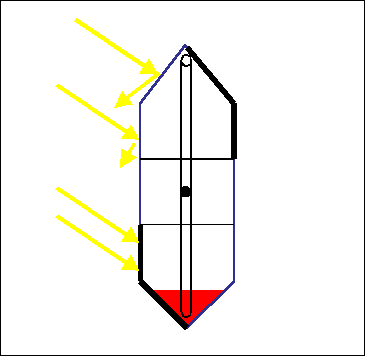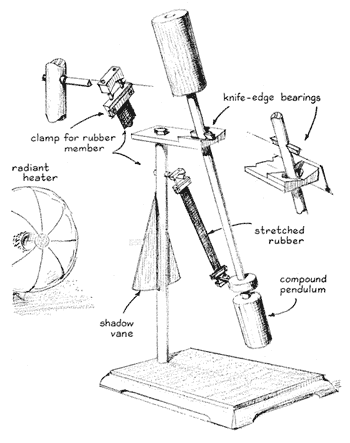| g e n u i n e i d e a s | ||||||
 |
 |
 |
 |
 |
 |
 |
| home | art and science |
writings | biography | food | inventions | search |
| solar rocker toys | ||
|
Solar Rockers are desktop toys which oscillate slowly in the sun, meant for gentle amusement rather than active play. This animation is a somewhat coarse and schematic, but does conveys the general principles of the stirling engine mechanism which powers this solar rocker (other designs based on different physical principles may be found here).
How it works: The Solar Rocker consists of an upper and lower sealed chamber, connected together by a thin hollow pipe. The entire apparatus rotates freely around the center axle, shown end-on above as a black dot in the middle of the image. A liquid (shown in red) can flow from one chamber to the other through the pipe. Each
chamber is painted white on one side, and black on the other.
The white side (the thin blue line above) reflects sunlight, while
the black side absorbs sunlight. So, if the black side is on the
lower chamber, it absorbs light and heats the air within the lower
chamber. This hot air expands, pushing the red liquid into the
upper chamber (for greater thermal efficiency, the actual design
supports the black layer inside the chamber, and a 30 c rise in
temperature is typical). With more liquid now in the upper chamber than the lower, the apparatus is unbalanced and flips over. The cycle repeats- once or twice a minute under normal conditions. The Solar Rocker is self-starting, whisper quiet, and mesmerizing. For example, click the picture to the right to watch an actual working model of the solar rocker in operation. For scale, the spheres are about 3 inches in diameter. The ability to blow such beautiful glass objects is a dying art- this example was fabricated by the excellent team at Vitri-Forms, Inc. CAUTION!! This is a toy, not a perpetual motion machine or mechanism which can be practically scaled in size to operate a car or run a pump. A
slightly more sophisticated rocker uses "flipping" vanes
in each sphere. The vanes are black on one side and silver on
the other. They are attached to the spheres at two bearing points
along a straight axle, and one side of the vane is weighted so
gravity always tips that side toward the ground. When the rocker
is placed in the sun, the black vane is in the bottom sphere facing
the sun. A reflecting vane is in the upper sphere. The Solar Rocker is very, very slow example of a Stirling Engine. Because the temperature differences from direct solar illumination are small, its efficiency is similarly reduced and produces very little torque. Commercial solar Stirling engines incorporate a lens or reflector to concentrate sunlight, resulting in a much higher temperature within the chamber. While most are built with a metal piston, some Stirling engines use liquid, such as this seesaw engine. Naturally, a larger wheel creates a larger force, but a low temperature hot air engine is never very efficient. Indeed, the brilliant engineer John Ericsson invented a hot air engine to propel a cargo ship in 1851- but to make it powerful enough to sail the oceans, the pistons were almost 15 feet in diameter and rose and fell 6 feet with every stroke. So gentle was the motion, that Ericsson placed a dining room table inside the piston chamber and held dinner parties atop the pistons as they cycled up and down! Unfortunately, the engines were so huge, there was no room left for cargo. Ericsson should have known better. Before Watt invented the first practical steam engine in 1776 and Stirling his "safer" low pressure engine in 1816, many others invented less efficient, but simpler steam motors. One of the earliest used a variation of what would later be called the sterling engine principle, the Amonton Firewheel of 1698
A fire sequentially heated air in the outer chambers, which then forced water to move between the inner segmented wheel's cavities.
If you would like to purchase a Solar Rocker, see the Mani Lamp at talusfurniture.com
|
||
Contact Greg Blonder by email here - Modified Genuine Ideas, LLC. |

 So, the bottom
sphere heats up, pumping liquid to the upper sphere, the rocker
tips, AND THE VANES ROTATE, so the black side is again in the
bottom sphere, with the shiny surface again in the top sphere
facing the sun. Fascinating to watch- tips about once a minute
in full sun.
So, the bottom
sphere heats up, pumping liquid to the upper sphere, the rocker
tips, AND THE VANES ROTATE, so the black side is again in the
bottom sphere, with the shiny surface again in the top sphere
facing the sun. Fascinating to watch- tips about once a minute
in full sun.
